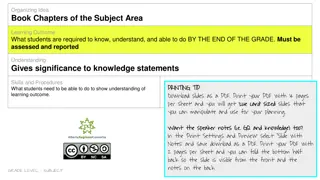Fundamentals of Mechanics: Introduction to Basic Quantities and Units
Explore the foundational concepts of mechanics in this introductory lecture, covering basic quantities like length, time, mass, and force. Learn about idealizations, units of measurement, SI units, conversion of units, and prefixes used in the context of mechanics.
Download Presentation

Please find below an Image/Link to download the presentation.
The content on the website is provided AS IS for your information and personal use only. It may not be sold, licensed, or shared on other websites without obtaining consent from the author.If you encounter any issues during the download, it is possible that the publisher has removed the file from their server.
You are allowed to download the files provided on this website for personal or commercial use, subject to the condition that they are used lawfully. All files are the property of their respective owners.
The content on the website is provided AS IS for your information and personal use only. It may not be sold, licensed, or shared on other websites without obtaining consent from the author.
E N D
Presentation Transcript
INTRODUCTION 1. Basic Quantities Length: is used to locate the position of a point in space and thereby describe the size. Time: is conceived as a succession of events . Mass: is a measure of a quantity of matter that is used to compare the action of one body with that of another. Force: considered as a push or pull exerted by one body on another. This interaction can occur when there is direct contact between the bodies, such as a person pushing on a wall, or it can occur through a distance when the bodies are physically separated.
2. Idealizations: Models or idealizations are used in mechanics in order to simplify application of the theory. Here we will consider three important idealizations. Particle. A particle has a mass, but a size that can be neglected. Rigid Body. A rigid body can be considered as a combination of a large number of particles in which all the particles remain at a fixed distance from one another. Concentrated Force. A concentrated force represents the effect of a loading which is assumed to act at a point on a body.
3. Units of Measurement The four basic quantities length, time, mass, and force are not all independent from one another; in fact, they are related by Newton s second law of motion, Because of this, the units used to measure these quantities cannot all be selected arbitrarily. The equality is maintained only if three of the four units, called base units, are defined and the fourth unit is then derived from the equation
SI Units (SI). (m), time in seconds (s), and mass in kilograms (kg). The unit of force, called a newton (N), is derived from F = ma . Thus, 1 newton is equal to a force required to give 1 kilogram of mass an acceleration of 1 m/s2 (N = kg . m/s2). The International System of units, the SI system defines length in meters W = mg (g = 9.81 m/s2) U.S. Customary (FPS). the U.S. Customary system of units, the length is measured in feet (ft), time in seconds (s), and force in pounds (lb), The unit of mass, called a slug , is derived from F = ma . Hence, 1 slug is equal to the amount of matter accelerated at 1 ft/s2 when acted upon by a force of 1 lb (slug = lb.s2/ft). m =W/g (g = 32.2 ft/s2)
Conversion of Units. Table below provides a set of direct conversion factors between FPS and SI units for the basic quantities.
Prefixes. When a numerical quantity is either very large or very small, the units used to define its size may be modified by using a prefix. Some of the prefixes used in the SI system are shown in Table below.























